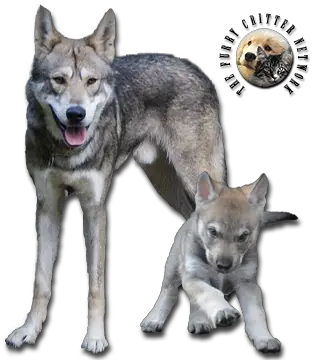History
In 1955, Karel Hartl began to consider crossing a Carpathian grey wolf with a German Shepherd as a scientific experiment in the military kennels in Czechoslovakia. A few years later, however, the idea was born to establish a new breed. The first hybrids of a female wolf named Brita and a male German Shepherd named Cezar were born on May 26, 1958 in Libejovice.
Puppies of the first generation resembled the wolf in appearance and behavior. Their upbringing was difficult; training was possible, but the results hardly matched the effort. In adulthood, they were again bred with German Shepherds, decreasing the proportion of wolf blood to 6.25% in the fourth generation. Most individuals of the third and fourth generations were able to attend a normal course and could be placed in service performance. Compared with dogs they had better navigational skills, night vision, hearing, and sense of smell. In tests of endurance, hybrids finished the entire 100 km route without being exhausted.
However, the breed-in-foundation repeatedly refused recognition, and in the 1970s, most breeding dogs were moved to the Slovak military kennels near Malacky, under the supervision of Vice commander Major František Rosík. In 1971–1981, litters were born only in Slovakia. In 1982, the Club of Czechoslovak Wolfdog Breeders was founded in Brno, with authority over the entire territory of former Czechoslovakia.
In 1982, the breed was again presented for recognition by František Rosík through the Club of Czechoslovak Wolfdog Breeders (now divided into Czech and Slovak Breed Club), and this time, it was recognized by the Czechoslovak breeders' associations as a national breed. The last addition of wolf blood took place in 1983. The wolf Lejdy of Ohrada Zoo in Hluboka nad Vltavou gave birth to the last line of the new breed, the father of the puppies being the German Shepherd Bojar von Shottenhof. Since that time, breeding has been carried out only in closed populations and the developed breed referred to as Czechoslovak Wolfdogs.
In 1989, it became provisionally recognized as FCI standard no. 332, group 1, section 1. It won the title of "World Champion" at the World Dog Show in Brno in 1990. Ten years later, in 1999, the breed confirmed its viability and met all the criteria of the FCI, earning full recognition of the Czechoslovak Wolfdog breed.
In 2012, the breed numbered 168 adult females and 170 adult males officially registered in the Czech Republic. As of January 2014, the most puppies each year are registered in Italy (up to two hundred), in the Czech Republic (about 100), and in Slovakia (about 50). The breed is growing in popularity in the UK too, with a number of Czechoslovak Wolfdogs working in Search and Rescue, supported by a dedicated Breed Club.
Behavior
The Czechoslovak Wolfdog develops a very strong social relationship, not only with its owner, but with the whole family. It can easily learn to live with other domestic animals that belong to the family; however, difficulties can occur in encounters with strange animals. It is vital to subdue the Czechoslovak Wolfdog's passion for hunting when it is a puppy to avoid aggressive behavior towards smaller animals as an adult. The puppy should never be isolated in the kennel; it must be socialized and get used to different surroundings. Female Czechoslovak Wolfdogs tend to be more easily controllable, but both sexes often experience a stormy adolescence.
The Czechoslovak Wolfdog is very playful, temperamental, and learns easily. However, it does not train spontaneously, the behavior of the Czechoslovak Wolfdog is strictly purposeful, it is necessary to find motivation for training. The most frequent cause of failure is usually the fact that the dog is tired out with long useless repetitions of the same exercise, which results in the loss of motivation. These dogs have admirable senses and are very good at following trails. They are very independent and can cooperate in the pack with a special purposefulness. If required, they can easily shift their activity to the night hours. Sometimes problems can occur during their training when barking is required. Czechoslovak Wolfdogs have a much wider range of means of expressing themselves and barking is unnatural for them; they try to communicate with their masters in other ways (mainly through body language, but also with quiet noises such as growls, grunts, and whining). Generally, teaching the Czechoslovak Wolfdog stable and reliable performance takes a bit longer than teaching traditional specialized breeds. The Czechoslovak Wolfdog has been successfully employed as a Search And Rescue (SAR) dog in Italy, although handling one requires much more work than other breeds.
This Wolfdog should be owned only by individuals who have an excellent understanding of animal behavior.
Function
Guard and Defense Dog.






